SCOUTED: Making the Leap (Part 2)
.png)
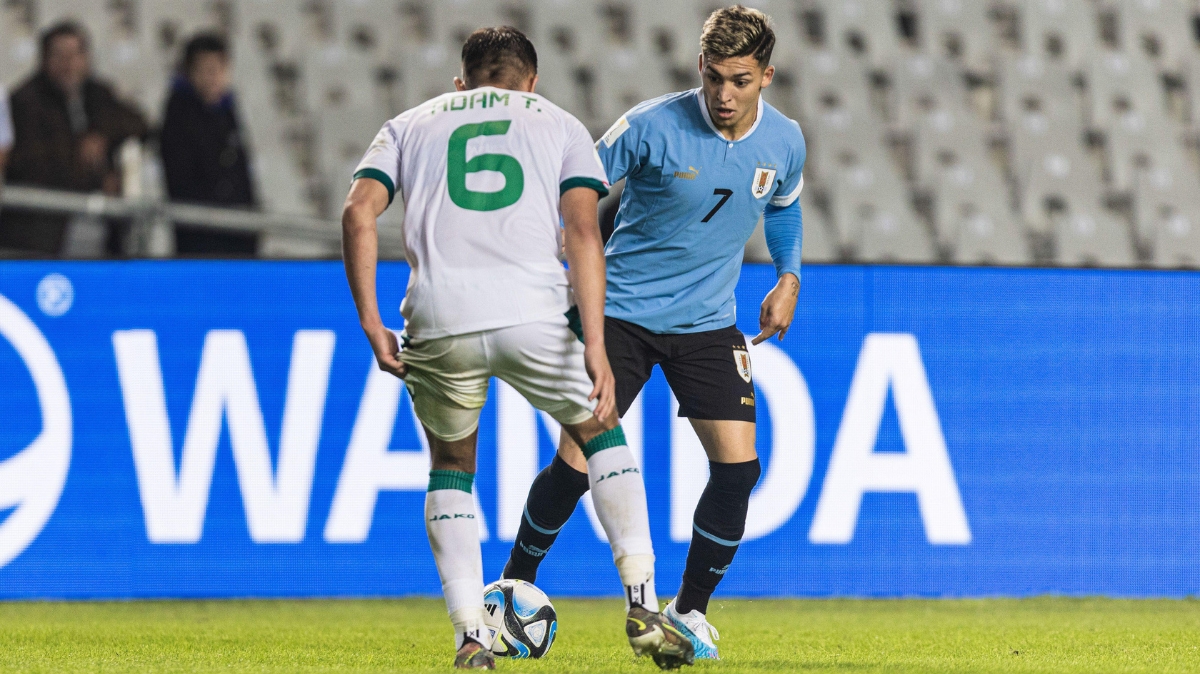
SkillCorner has partnered with Scouted Football, providing data and insights to support their writing on the best emerging talent in football. In part two of this article, the Scouted team used our data to analyse the gap between youth and senior football at the elite level.
If you haven't read Making the Leap: Part 1, click here.
After our first round of investigations running the microscope over SkillCorner’s data package, we’ve learned two important things: senior footballers are faster and run with more intensity, and they can deal with pressure, and execute under it, more easily.
That leaves us with the next two SkillCorner metrics to cover: Off-ball Running and Passing (to Runs).
Speaking purely on hypotheticals, I am intrigued to see how the seniors set themselves apart from the juniors in these metrics. Do they make more runs? Do they make smarter runs? Are they more efficient at finding passes to runs/dangerous runs? Are they more aggressive at looking to pass to runs?
To remind you all, we are looking at the senior men’s, Under-20, and Under-17 World Cups from 2022 and 2023 respectively. Please again bear in mind the small, tournament-sized sample we are working with too.
Now, let’s go find some answers.
Off-ball running
SkillCorner’s off-ball running data can show us some very important trends. Let’s start first with some stats that relate to volume: Runs per 30TIP and Dangerous Runs per 30TIP.
OK, table time.

This table is a bit of a doozy. We see the least runs at at under-17 level and the most at under-20 level, with the seniors wedged in-between. This correlates closely with the number of dangerous runs made at each of the three levels. If there’s anything to deduce from this, it’s that the volume of runs made does increase as players get older, but that it happens quite early in the development cycle.
But the volume of runs made is not the be-all-end-all of the dataset, we can get much more granular to work out more key differences between the levels.
For this, we are going to split the overall sample into only strikers at their respective tournaments. First up, we’ll take a look at the percentage of runs made that were dangerous, and the threat of these runs averaged out on a per 100 run basis. The results start to tell a story of how attacking is ‘easier’ in youth football.
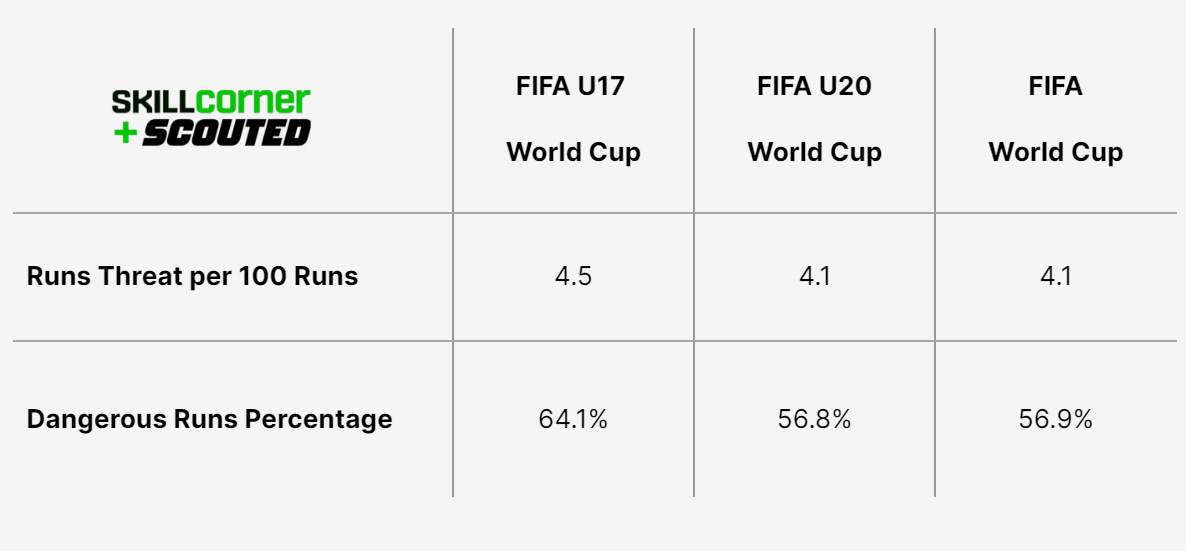
What we can see from this table, is the decline of both runs threat per 100 runs and dangerous runs as a percentage of overall runs as we move up from under-17 level (although interestingly, the under-20s and seniors are very aligned here). Quite clearly, it is harder for strikers and wingers to find spaces for dangerous runs against more compact and organised defences, finding less value — or threat — from each individual run.
We can dig a little deeper into why this might be the case. Sampling the same group of players, let’s take a look at their ability to make dangerous runs in behind, and then receive the ball.
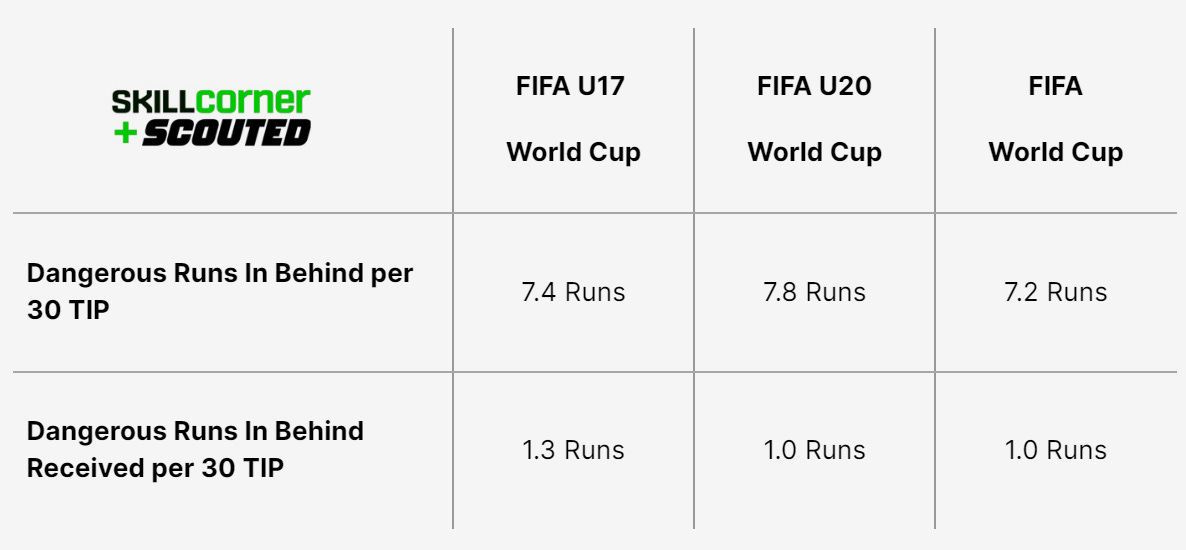
The difference here is stark. Strikers at under-17 level are afforded the space to make and receive the ball with dangerous runs in behind at a much higher rate than the under-20s and seniors. They receive 0.3 more passes to dangerous runs in behind than the equivalent attacker at senior level does. This is crucially important, as this is the type of run that correlates most closely to scoring.
If you are a fast, line-breaking attacker, you are going to find a lot more joy playing at under-17 level than senior level — that’s something to keep in mind when evaluating a young attacker’s overall portability to senior football. Is a lot of their success being derived from things that are ‘harder’ to do at senior level?
We’ll push this example out even further. Next, let’s take a look at how this set of players turn runs into shots, both in terms of volume and efficiency.
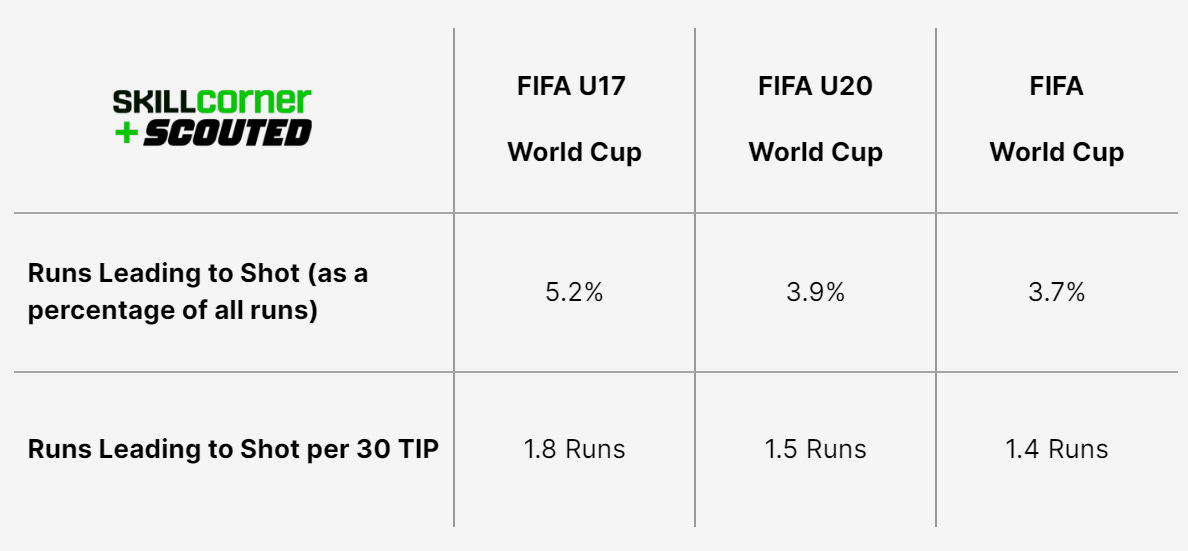
I’d suggest the most intriguing thing here is the similarity between the under-20s and seniors, before the volume and efficiency of runs leading to a shot ramps up massively at under-17 level. Again, this might be something to think about when assessing players at that level — while there are still some differences and a quality gap, the feel and shape of a game for an under-20 level competition might not be enormously different to senior level.
On the other hand, this set of graphs very clearly shows how much value an attacker can get out of making runs at under-17 level, with around a 0.4 gap in runs leading to a shot per 30TIP in comparison to the seniors — that’s huge.
There are so many types of runs that we could go on forever, but let’s move onto passing now.
Passing
The ability to execute passes can be a game-changer in separating the best from the rest. Naturally, we are going to expect to see senior players being more efficient with their passing, but what other nuggets of interesting information can we garner from SkillCorner’s suite of passing data?
Again, let’s start off with some volume data on opportunities to pass to runs, and attempts to pass to runs, per 30TIP. This data should give us an indication about how aggressive players are at looking to pass to runs.
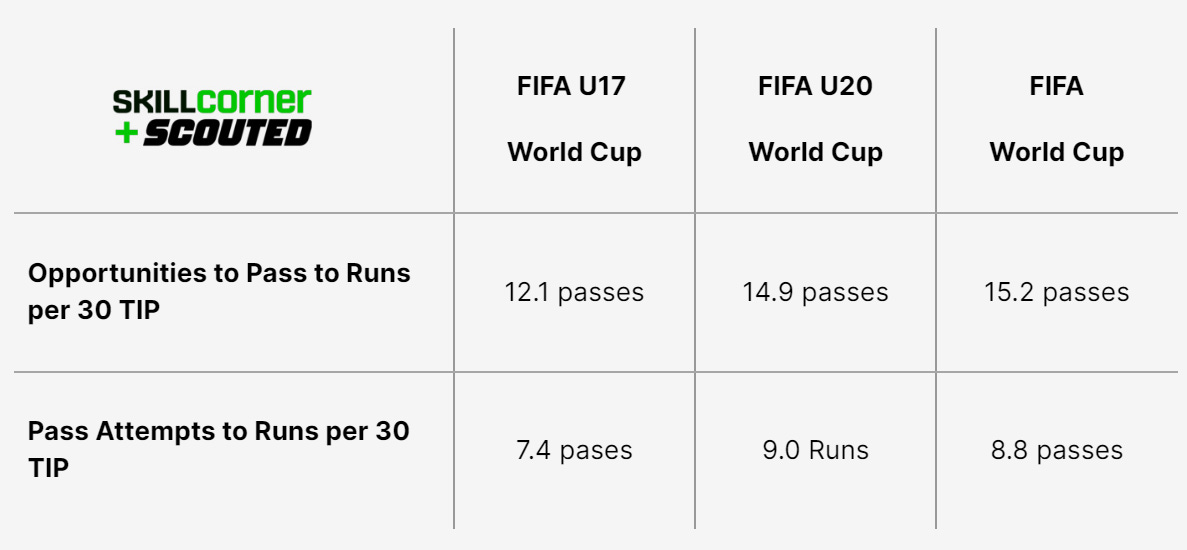
To start, this data shows that senior players are more selective when passing to runs, as they make the fewest attempts to pass to runs as a proportion of their opportunities to pass to them (58% compared to 61% for the under-17s and 60% for the under-20s).
There are two trains of thought here. First, that senior players are prepared to take on less risk with possession. The other is that it’s ‘easier’ for under-20s and under-17s to make passes to runs.
Digging a little deeper, we can categorically rule the second part of the hypothesis out. Whether it’s because of a better ability to select the right passes to make, or simply better execution, senior players are much better at completing passes to runs.
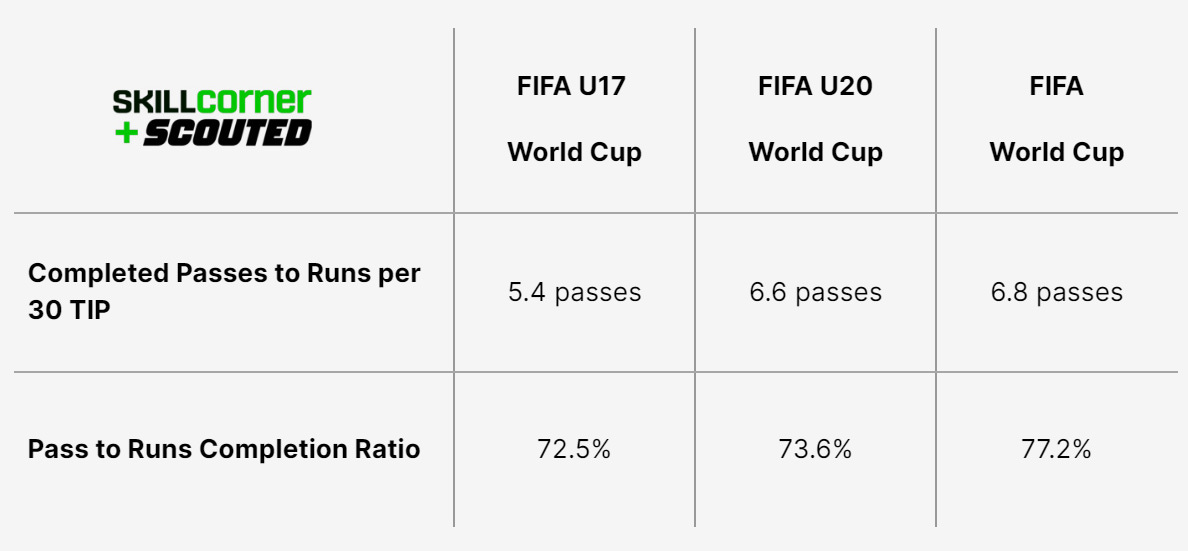
This surprised me quite a lot. In part one we covered how senior players dealt much better with passing under high pressure than the under-20s and under-17s; however, I felt that even though there were more high pressures received at the junior levels, that they would counter-balance this with more ‘easy’ completions in low/no pressure scenarios.
Instead, we are talking about a very substantial gap (around 5%) for the completion ratio of passes to runs. As I also noted in part one, multiplying this gap by the 20 outfield players on the field in any one game, you start to comprehend the enormity of the difference in quality in this statistic. And clearly it is not a gap that is bridged at under-20 level either - it is a metric that the senior players have a very defined advantage in.
Lastly, let’s take a look at some threat data, and see how this extra efficiency and more completed passes for runs at senior level translates into threat as measured through SkillCorner’s threat model.
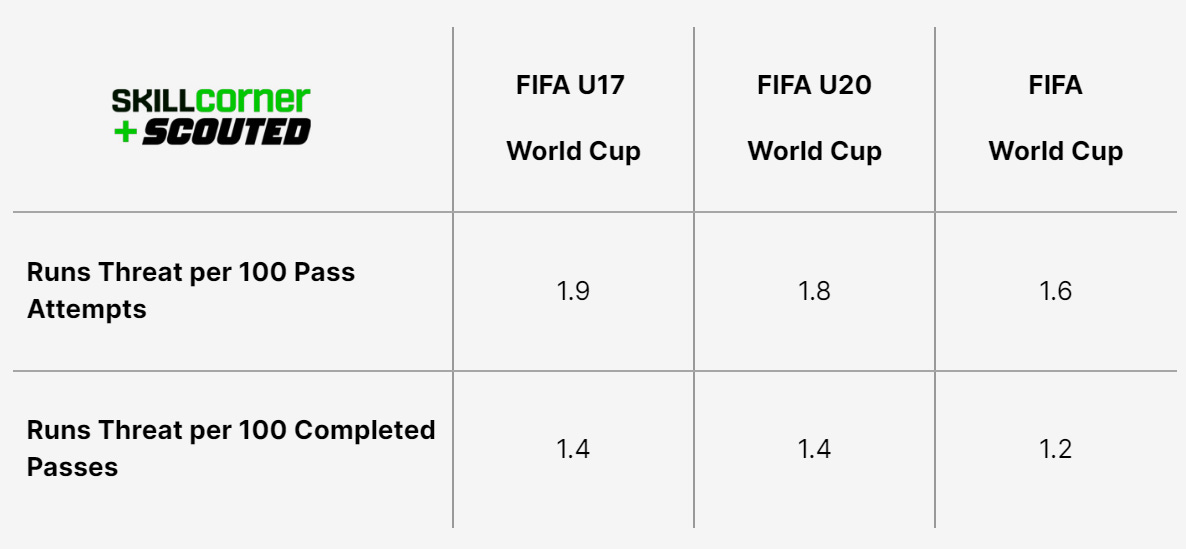
The short answer is no, it doesn’t result in more threat. This ties back to the off-ball running data we looked at earlier, but it is still amazing to see how the on-ball quality of senior players is neutered by how much more difficult it is to make high-value dangerous runs.
This suggests to me that while they may not be as talented overall as a cohort at passing compared to the seniors, the off-ball freedom of midfield and attacking players at under-17 level against less structured, less physical defensive groups, means the passer gains outsized value when they are able to complete passes.
Conclusion
Over these two pieces, we’ve run through a lot of different ideas and concepts, so let’s try to sum up exactly what it all means and how we can put it into practice.
At the start of part one, I talked about how we might use these findings to try to understand and quantify the gaps between youth and senior competitions, and then how we can use that understanding to start to understand how a player might be classed as ‘ready’ to jump between youth and senior level.
In quantifying the gaps, I think we made some great progress.
We’ve seen the increases in speed and intensity at senior level as measured through PSV-99 and Sprinting Distance P60 BIP. This undoubtedly has an enormous impact on the shape and feel of a senior game both offensively and defensively, with faster transitions and wing play counteracted by defences that cover transitions quicker and can set up their defensive structure faster too.
We’ve also noted that senior players are much better at retaining possession under pressure, and especially under high pressure. Our conclusion wasn’t just that senior players are inherently better at facing these situations (although their ability to execute difficult passes under high pressure suggests that’s also true), they are also taking less risks when they receive pressure by finding passes before they are able to be dispossessed.
Next, and crucially important, we have identified that attacking runners at youth level are able to get incredible bang for their buck. Runs made at under-17 level are simply able to find so much more value. Whether it’s because of the lower level of athleticism or quality of the defenders at that level, or it’s poorer defensive systems, we can see how much more impact attackers can have at under-17 level, especially with the all-important runs in behind.
And lastly, we have seen that senior players executed passes to runs much more efficiently than the youth players in the set of World Cups we have covered.
So what does this all tell us about portability from youth to senior football?
Well, there’s probably a whole piece in this for another time, but I think it’s worth bearing in mind a couple of key points:
- Be aware of players excelling in things that are ‘easier’ to do at youth level. Is a striker in a dominant under-17 team walking waltzing past the defensive line and scoring lots of goals? It’s not so easy to do that at senior level. Is a very un-athletic player able to completely take over games? Watch out, when the speed and physicality ramps up at senior level they are more likely to be crowded out of games.
- On the contrary, think about what players are doing things that are more unique at youth level. Is a player incredibly efficient, bordering on being risk-averse? They are probably more likely to fit in at senior level. Are they an athletic freak that can not just excel in bursts, but can keep going for longer and harder than the other players on the field? That’s a big positive. Are they able to consistently execute under high pressure? etc. etc.
Above all, hopefully this piece can help us all to look at youth football with a more critical lens. At times it can be a bit of a mirage, given we can now see there are huge fundamental stylistic differences to the senior game.
Understanding these differences and applying them successfully as a scout is an almost priceless skill.
Written by Steven Ganavas.
Click here for more information on our football products.
Click here for more of Scouted's writing on emerging football talent.